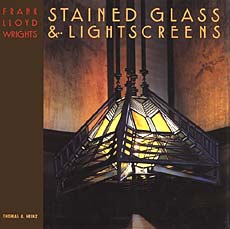|
"Glass and light — two forms of the same thing!"
Frank Lloyd Wright,
"Architectural Record," May 1928 |
In his book "Frank Lloyd Wright’s
Stained Glass & Lightscreens," Wright scholar Thomas Heinz examines
one of the most interesting aspects of the famed architect’s career:
his work with art glass and lightscreens (defined by Wright as
"something that would modify the pattern or view of light in an
opening").

Heinz became interested in art glass in
his youth; his interest was further piqued when he saw examples of
Wright’s windows at the Art Institute of Chicago. His research on
Wright’s glasswork began after receiving his degree in architecture
from the University of Illinois, Urbana.
In describing Wright’s unique approach
Heinz makes distinctions between stained glass (the painting of a
material fired onto the surface), art glass (the artistic fashioning
of glass in any form) and lightscreens.
The book’s 11 chapters contain the
evolution of Frank Lloyd Wright’s innovative accomplishments in art
glass and lightscreens.

In "Before Wright" Heinz describes the
early development of glass patterns in the United States, the
architects who began using colored glass and the emergence of
Chicago as the center of the art glass movement.
"Traditional Beginnings" chronicles
Wright’s period of learning and experimentation and includes some
early examples of his cut wood screens and borders in glass windows.
His interest in the newest technologies
is examined in "First Experiments in Materials." It is during this
time that Wright perfected the technique of creating glass designs
without cames (lead rods that hold the panes together). His
association with William Winslow led to Wright’s role as consultant
for the Luxfer Prism Company and their new electro-glazing process.
[to top of second column in
this review] |
\
Several important houses are featured
in "First Successes in Pattern." These early success stories
represent a prolific period of output during Wright’s career as he
became more confident in his use of art glass and lightscreens. The
Illinois homes in this chapter illustrate Wright’s growing mastery
of this medium and his ability to influence and manipulate light.
The later chapters on "Success in
Materials," "Simple and Less Costly Patterns," and "Developments in
Abstraction" demonstrate Wright’s continued experimentation with
light and glass and represent a body of work ranging from
traditional and contemporary patterns and effects to more abstract
pieces. Regarding this period of work in Wright’s career Heinz
writes that the designs "parallel and in many ways precede similar
advances in the field of abstract painting."

Of particular interest are the many
examples from the Susan Lawrence Dana House in Springfield. It is
during this project, according to Heinz, that Wright came into his
own as an architect: "He seemed to be the only artist working in
glass and metal who understood the graphic effects possible using
the full palette of these materials. While most designers thought of
the metal only as a way to hold the glass pieces in position, Wright
treated it as an important part of the design."
The remaining chapters in the book
discuss Wright’s development of patterned concrete panels for
lightscreens, exploring the use of glass tubes and panels, and,
nearing the end of his career, returning to an influence from his
early days: designing wood lightscreens with cutouts.
"Frank Lloyd
Wright’s Stained Glass & Lightscreens" is an outstanding work of
scholarship that captures the essence of Wright’s groundbreaking
designs. The book’s stunning illustrations and lavish photography
showcase Wright’s creative genius and prove that he was years ahead
of his contemporaries in understanding the effects of light and
shadows and how to manipulate and control them. This book is
recommended for anyone interested in art, architecture, interior
designing or the remarkable career of Frank Lloyd Wright.
[Richard Sumrall, Lincoln
Public Library District]
|